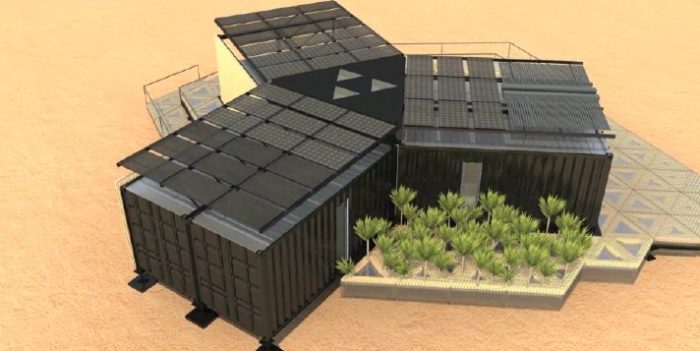
Image Credit: Tongji University
Image Credit: Tongji University Y Container construction involves three basic steps. The first is to “transform” a set of six containers by cutting out holes for windows, doors, and mechanical equipment. The second step in the conversion of shipping containers into Team China’s Y Container house is to install photovoltaic modules on roof-mounted racks, add insulation to the shell, and install bamboo facing on the exterior walls. The third step in the conversion is the addition of decking around the container assembly. Each of the three spurs of Y Container is designed for a specific set of functions. The north spur of the house, just above the multifunction area depicted in the schematic, features a garden area to the east. Bifacial photovoltaic panels are mounted on elevated frames. The panels shade the container rooftops but also absorb light bouncing off the containers' reflective surface. The basic layout scheme for the version of Y Container that will be shown at the Decathlon. A view of the interior from Y Container’s main entry. The open area just off the kitchen. The windows in each spur of Y Container offer a 120-degree view of the landscape. Y Container’s flip-down bed, hidden storage, and sliding panels. A live/work area off the spurs pointing south and northwest. The home’s system of water-collection pools is integrated into the exterior decking.
Team China’s Solar Decathlon 2011 entry, Y Container, pushes hard on the notion that shipping containers can be as comfortable to live in as they are easy to transport from mainland China to Washington, D.C. A collaboration of students and faculty at Tongji University in Shanghai, Y Container is essentially three pairs of modified shipping containers, with the containers in each pair placed side by side and the three duets then arranged into a Y-shaped dwelling with cutouts for windows and doors. The exterior sides of the structure are layered with rigid insulation under bolt-on zinc-plated steel sheets, creating a waterproof, reflective shell that enhances the performance of the bifacial photovoltaic panels mounted on the rooftops of the spurs. The bottom spur of the Y points south and includes a living room and small balcony. The left spur of the Y (pointing northwest) serves as the kitchen area and the right spur (pointing northeast) houses the bedroom. Bamboo facing shades most of the exterior walls.
Team China: Three Steps to Make a Y Container
The covered, triangular center section of the Y, where the three container pairs converge, defines what the team calls a “multifunction” area that serves both as a passageway and a nexus for social activity. The corners of the triangle are equipped with downspouts for water collected on the rooftops of the spurs and on the central-area canopy. The water flows from the downspout to collection pools that are integrated into the exterior decking. Three takes on the landscape Beyond the portability of the assembly and the relative ease with which the containers can be modified for other configurations, Y Container, by virtue of its shape, offers a 120-degree view from each spur, which enhances the interior daylighting of the house and, when combined with the project’s varied decking and landscaping strategies, makes the surrounding area seem expansive.
MORE INFORMATION Team China Web page DOE Web page for Team China GBA Resource Guide for 2011 Solar Decathlon
We’ve asked Team China for information about a number of details, including square footage, insulation values, windows, airtightness, and the project’s mechanical systems, which, in addition to the PV array, include solar thermal and a cooling system. We do know, however, that the team aims to be competitive in the Decathlon’s affordability contest, with projected construction costs coming in at just under $270,000.
Weekly Newsletter
Get building science and energy efficiency advice, plus special offers, in your inbox.















0 Comments
Log in or create an account to post a comment.
Sign up Log in